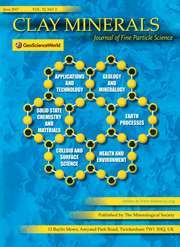Article contents
Mineralogy and petrography of the ordovicial “metabentonites” and related limestones*
Published online by Cambridge University Press: 14 March 2018
Extract
A series of samples of “metabentonites,” here referred to as K-bentonite, and related limestones were collected from the Upper Black River and Lower Trenton formations of the Ordovician System in Central Pennsylvania. The K-bentonite occurs in yellow and gray beds which range from half an inch to ten inches in width.
X-ray diffraction patterns of the 22 K-bentonite samples are similar to those for illite and have the (060) reflection at 1·50Å indicating that the clay mineral is of the dioctahedral variety. However, the value of the (001) reflection ranges from 10·2 to 10·6Å, suggesting that the material is a mixed layer clay composed of expanded and non-expanded layers of hydrous mica (montmorillonite and illite). This possibility was tested by saturating the clay with H, Ca, Na, K, NH4, and ethylene glycol and noting the effect of the treatment on the position of the (00l) spacings in the X-ray diffraction patterns. Using the curves published by Brown and MacEwan (1950) for the analysis of mixed layer complexes, it was found that approximately 20% of the layers are expanded and 80% are not. This ratio is supported by chemical analyses which show that of the exchangeable cations 20% are calcium, sodium, and magnesium and the remaining 80% is potassium.
- Type
- Research Article
- Information
- Copyright
- Copyright © The Mineralogical Society of Great Britain and Ireland 1952
Footnotes
This paper represents some of the results of research on the morphology, structure and origin of fine-grained minerals conducted in the Division of Mineralogy of The Pennsylvania State College and supported by the Office of Naval Research.
References
- 8
- Cited by


